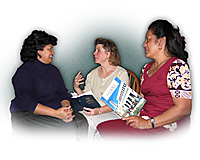Visiting Teaching Lesson
December 2013
December 2013
Contact your sister by the 5th, make an appointment by
the 10th, visit by the 15th and report by the 20th
The Divine Mission of Jesus Christ: The Only Begotten Son
Prayerfully study this material and seek to know what to share. How will understanding the life and mission of the Savior increase your faith in Him and bless those you watch over through visiting teaching? For more information go to reliefsociety.lds.org.
This is part of a series of Visiting Teaching Messages featuring aspects of the mission of the Savior.
Our Savior, Jesus Christ, is called the Only Begotten Son because He is the only person on earth to be born of a mortal mother and an immortal Father. He inherited divine powers from God, His Father. From His mother, Mary, He inherited mortality and was subject to hunger, thirst, fatigue, pain, and death.
Because Jesus Christ is the Only Begotten of the Father, He was able to lay down His life and take it up again. The scriptures teach that “through the atonement of Christ,” we “obtain a resurrection” (Jacob 4:11). We also learn that all “might be raised in immortality unto eternal life” if we “would believe” (D&C 29:43).
As we come to understand more fully what it means for Jesus to be the Only Begotten Son of the Father, our faith in Christ will increase. Elder D. Todd Christofferson of the Quorum of the Twelve Apostles said, “Faith in Jesus Christ is the conviction and assurance of (1) His status as the Only Begotten Son of God, (2) His infinite Atonement, and (3) His literal Resurrection.” Modern prophets have testified: “[Jesus Christ] was … the Only Begotten Son in the flesh, the Redeemer of the world.”3
From the Scriptures
John 3:16; Doctrine and Covenants 20:21–24; Moses 5:6–9
From Our History
In the New Testament we read of women, named and unnamed, who exercised faith in Jesus Christ, learned and lived His teachings, and testified of His ministry, miracles, and majesty. These women became exemplary disciples and important witnesses in the work of salvation.
For example, Martha bore strong testimony of the Savior’s divinity when she said to Him, “I believe that thou art the Christ, the Son of God, which should come into the world” (John 11:27).
Some of the earliest witnesses of the Savior’s divinity were His mother, Mary, and her cousin Elisabeth. Soon after the angel Gabriel visited Mary, she visited Elisabeth. As soon as Elisabeth heard Mary’s greeting, she “was filled with the Holy Ghost” (Luke 1:41) and bore testimony that Mary would become mother to the Son of God.
What Can I Do?
Why is it important for me to understand the roles of Jesus Christ?
How do covenants increase our faith in the Savior?
Notes
See Gospel Principles (2009), 52–53.
D. Todd Christofferson, “Building Faith in Christ,” Ensign, Sept. 2012, 53; Liahona, Sept. 2012,
“The Living Christ: The Testimony of the Apostles,” Ensign or Liahona, Apr. 2000, 2–3.
Official Web site of The Church of Jesus Christ of Latter-day Saints
© 2013 Intellectual Reserve, Inc. All Rights Reserved

